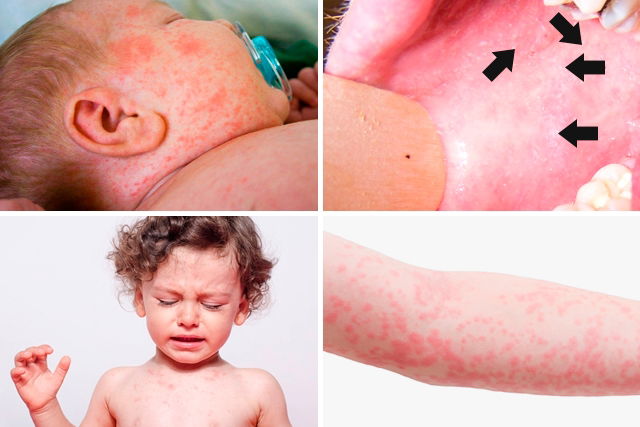Measles symptoms will initially appear to be cold or flu symptoms, as this disease usually presents with a sore throat, dry cough, muscle pain, excessive fatigue and a fever.
These first measles symptoms typically appear between 8 and 12 days after initial contact with the virus. It is common for the red spots or rash associated with a measles infection to appear about 3 days after the first symptoms. These spots usually spread throughout the body and do not itch.
Measles is caused by a virus from the Paramyxoviridae family, and is transmitted from person-to-person through droplets of saliva from an infected person. It can also be transmitted through contact with stool particles from an infected person. Vaccination is the best way to prevent this disease.

Common symptoms
The main symptoms of measles are:
- Red rash on the skin that does not itch and spreads quickly throughout the body
- Sore throat
- Dry cough
- Muscular pain
- Excessive fatigue
- Fever over 38ºC (or 100.4ºF)
- White spots inside the mouth
- Red eyes
Measles is a viral infection that primarily affects children in their first year of life. However, measles can be caught by children over 1 year and by adults who have not been fully vaccinated. Cases are most commonly seen in the summer and fall.
Online symptom checker
If you think you or someone you know may be infected with measles, report the symptoms below:
Please note that this quiz is only a guidance tool and does not replace a consult with your doctor or a diagnosis. If you have any questions about your symptoms, you are advised to seek medical attention.
Confirming a diagnosis
Measles diagnosis is confirmed by a pediatrician for children and a general physician in adults. The doctor with start by evaluating the presenting signs and symptoms. These may be similar to rubella, chickenpox, roseola or even a medication allergy. The doctor can confirm the measles virus by ordering lab tests, like blood work, a throat swab or a urine test.
If you suspect you may have measles, it is important to avoid contact with other people until you have been assessed. This virus is easily transmitted through coughing or sneezing, therefore you should use a mask until you have seen a doctor.
Possible complications
Measles complications are most seen in children less than 5 years old, and adults over 20 years old. Many of these patients experience pneumonia, diarrhea and an ear infection. Another complication of acute encephalitis, which emerges around the sixth day after the rash appears.
Treatment options
Measles treatment consists of symptom management through rest, fluid intake and a bland diet. This is a type of diet made up of soft foods that are well-cooked and/or processed to make chewing and digestion easier. Learn more about the bland diet.
Measles treatment also Read the use of medications such as acetaminophen and vitamin A supplements, which should be prescribed by a doctor. Learn more about how measles is treated.
Measles is most commonly seen in children, and treatment in this population is aimed at managing symptoms like fever, general malaise, appetite loss and red rashes (which may erupt into small, ulcerated wounds).






























